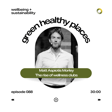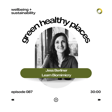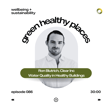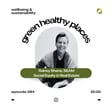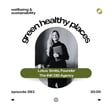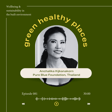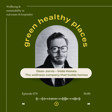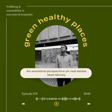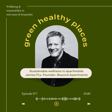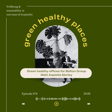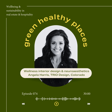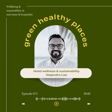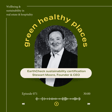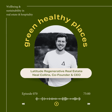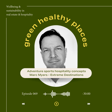Introduction to Episode 75
00:00:12
Speaker
Welcome to episode 75 of the Green Healthy Places podcast, in which we discuss the themes of well-being and sustainability in real estate and hospitality. I'm your host, Matt Morley.
Interview with John Harrison
00:00:25
Speaker
And in this episode, I'm in Amsterdam, in the Netherlands, talking to John Harrison. He's president of Sustainable Production, sometimes abbreviated to ASAP. That's a women-owned global sustainability and wellness consulting firm.
00:00:39
Speaker
that specializes in implementing the LEED green building and well healthy building standards at scale. He's also a strategic advisor for B Corporation out of Hong Kong, another big LEED certification company that one specialized in the retail sector. John is a LEED fellow, a licensed architect, and one of the world's experts on applying sustainable strategies at scale in real estate. While at Starbucks, he played a pivotal role in implementing over 1600
00:01:06
Speaker
green certified stores in 22 different territories, making it one of the most successful green building programs of its kind in the retail world.
John's Career Path and Role at ASAP
00:01:14
Speaker
He also spent 13 years at Methun in Seattle, one of the leading sustainable design practices in the US, and a practice to have on your radar if you're even remotely interested in green building architecture. He also recently hired one of my ex-team members, Hannah Schab, a talent at Stanford grad, destined for great things. So I know he has a good taste in recruitment. John, thanks for taking the time to be here.
00:01:35
Speaker
Thanks, Matt. So let's dive in. Perhaps you could describe your role at ASAP, what the team looks like there. Obviously, you're in Europe, the rest of the team split between Europe and the US as you understand it. Correct. So Jennifer Berfel at Jelvik, who's the founder is actually based out of Los Angeles and has been for the entirety of the time the company has existed. So it's, I think, 11 years now.
00:02:00
Speaker
She and I don't each other for quite a while before I left Starbucks at the end of 2019. And she's made herself kind of the preeminent well AP in the world. And the International Well-Building Institute at that time and around 2019 was starting to really commit to a portfolio based solution.
Sustainable Strategies in Real Estate
00:02:24
Speaker
They had existed for a few years and had built the certification platform, but we're looking to move toward something that was more inclusive of broader business portfolios. Jen had known that I had obviously been with Starbucks for many, many years and had built that program there that was able to take lead volume and build it at scale. We began talking about how we could partner up to
00:02:55
Speaker
take the sort of the scale knowledge that I have and sort of the corporate side that I'd learned from that time and combine it with the well knowledge she had and apply that to portfolios that were looking at this particular program at the time. She had a few that she was looking at and then as time evolved, we added a few more and various typologies and we're able to execute some fairly big numbers with some ratings and certifications and that sort
Certification: Location-Specific vs. Virtual?
00:03:23
Speaker
It's a powerful double team. For anyone who hasn't been through the process or who is considering that certification could be on the cards for a project that they're looking at in real estate, how location specific is it based on if you have a project in one city, do you need necessarily to find a certification advisory consultancy in the same city, the same state, same country even, or is it pretty much delivered online virtually nowadays?
00:03:54
Speaker
So it's pretty much delivered online virtually. And a little bit with the pandemic has made that happen, or has facilitated a different look at things. I think that it, especially when it came to lead projects, you probably would have a little bit more, or BRIAM, or whatever certification system it is, you would have a little bit more of a regional or local approach. And you still get that a little bit with larger projects. But when you're working with,
00:04:23
Speaker
national and multinational corporations, and even some individual projects, which I've done over the last few years, too. It's really not, it's not dependent on that anymore. And the standards and systems are, at least in the majority of the world, fairly universal. Now, at Starbucks, having to apply a lead volume program to some countries, you know, I would say, probably a little less evolved in formality,
00:04:52
Speaker
Um, you know, like there's some places in Asia, it's places in Latin America. Um, it takes a little bit more, um, guidance. Um, but you can still do it all remotely, which we, you know, which we did then, and we pretty much been doing now for the whole time. So, you know, I'm in Amsterdam. It gives me opportunity to, um, uh, interact with leadership from IWBI, for instance, that, cause they have a whole leadership team in Europe.
00:05:15
Speaker
Um, so I've been at a couple of conferences and that sort of thing, um, you know, speaking and, um, you know, having access. Um, but you know, the majority of what I've done over the last few years, um, in the last couple of years in the Netherlands, I sit at a desk in front of a screen, just like we're doing right now. And, um, uh, it's just that the meeting times are interesting sometimes with the time differences, but, um, you're able to do work back in the U S able to communicate and do work in Asia.
00:05:42
Speaker
and obviously on this continent because you're in the same time zone, but it's totally changed over the last few years.
00:05:50
Speaker
Yeah, it makes sense.
Scaling Sustainability Certifications
00:05:51
Speaker
And you mentioned delivering projects at scale. Let's just dig into that a little bit. So what would a typical context be there when a client comes to you? They already have an existing portfolio of properties, and suddenly they wake up to the idea that perhaps certification would be good, and they think, well, we have 10 different buildings. Let's do all 10. Or is it a very more nuanced situation, typically, where a client comes to you with a portfolio?
00:06:21
Speaker
Yes and yes. So we kind of see it all. And for me, it kind of goes back to some realizations that came to bear at Starbucks. So I'd worked on a lot of really interesting retail hospitality, but also education-driven things at Methuen. And we were kind of on the forefront of LEED as it was starting to emerge in the late 90s. It had some of the first and various categories for
00:06:51
Speaker
for lead projects. But they were all one-offs, and I'd never really considered the certification to be the point. It was always trying to do the best thing by the project, trying to do the best thing by the client, and then the certification was just sort of this reward you got at the end. But what became to be real apparent as we were building the Starbucks program was that in order to do things where you have hundreds and hundreds, if not thousands, of people who need to
00:07:21
Speaker
chime in and help guide a system that brings a lot of projects into the ability to be certified or at least to be accounted for in some way or another. You need systems.
00:07:39
Speaker
And that's what well at scale as they call it now was well portfolio and what lead volume were kind of designed to do was to be able to do things en masse. And doing things en masse is where the real impact happens too because you can, as an architect, I could have just spent my whole career doing one individual green building at a time, but when you are able to apply,
00:08:05
Speaker
standards across an entire portfolio, you have a much bigger impact with regard to conservation, carbon, et cetera, et cetera, impact on people. So what's happening now is companies are looking either from an ESG standpoint where they want to make a splash and be able to report or looking on the scale of, you know, just trying to affect a portfolio.
Impact of Large-Scale Standards
00:08:36
Speaker
They're seeing these examples and they're trying to do that in a way that affects more than just one building. So we have clients, we have a client in the Philippines, for instance, that has, I think it's three or four major high-rises that they have built and operate as offices of mixed use. So they just have a small portfolio and that fits into the system just fine. And we did well health safety ratings for them. And then we also did,
00:09:03
Speaker
a massive amount of well health safety ratings for T-Mobile USA, where they were looking to try and make sure that somewhere around 24, 2,500 assets were able to get some sort of recognition through the well at scale program. So you can kind of, and mixed typologies too, some were CRA projects or corporate real estate, and a huge portion of it was actually on the retail side.
00:09:32
Speaker
So it just depends. It's there, and then it's all and everything in between. So the scale part of it can be hundreds, if not thousands, down to a few entities.
00:09:46
Speaker
And another way then to think about a certification process that has a degree of scale is also with a community where it's perhaps bigger than just four walls, no matter how big the building is, but perhaps something like a campus or an entire village within a town or a district under development. So again, you're applying
00:10:09
Speaker
your same knowledge, but a different challenge in a way, right? So you're having to customize the approach there to lead them well or to lead them well adapt now well enough to the idea of a community level standard? Yeah, it's both. They both have, especially on the lead side, they have community level and kind of city level scale that you can apply. But what we found, and there are a couple of projects that we're working on right now,
00:10:38
Speaker
on the ASAP side that our development communities, they're using a variety of approaches. They might be using a particular relay or something for resiliency. They may be using
00:10:58
Speaker
well more geared toward residential for some of that part of the project. Or in one case, they might be using LEADS platform for residential. So you can kind of do it in combination. And I think that's the biggest thing, though, is that when you start talking to someone who has this project or another kind of project is that the mind share and
00:11:22
Speaker
the late 90s when we first started doing LEAD was, you know, in my architectural career, that was it pretty much, you know, and BRAM was emerging at some point. And there were other like CASB in Japan, there were other programs kind of emerging, but there wasn't a lot of variety. And there, they didn't, you know, they were kind of almost exclusively focused on
00:11:46
Speaker
conservation and waste diversion pretty much. There wasn't a lot of depth beyond that. But now there's so many different systems that can be applied. And you can also apply them in a custom fashion where you pick pieces of one and pick pieces of the other that you want to apply. So I know it's a long-winded explanation, but it can be both. There are constructs where you can fit an entire community of some sort of scale into a rating system or
00:12:14
Speaker
with a community or any other kind of scale project, you can use a variety of different inputs from different rating systems to get the client where they want to get to.
LEED and WELL Standards Post-COVID
00:12:27
Speaker
Have you sensed that LEED is responding to evolving market dynamics or has it, in a sense, led from the front? I mean, one can't help but notice the recent arrival or relatively recent arrival and massive upsurge and interest in WELL and then LEED slowly sort of nudging
00:12:48
Speaker
Closer to picking up a few more of the sort of healthy and wellness terminology along the way it's sort of through later iterations how do you see that around a standard that is fixed as a standard that's in evolution is it is it more the latter and it's having to adapt constantly and reiterate. It so i guess the honest answer is that it didn't really it didn't really reinvent itself for a while so.
00:13:15
Speaker
LEED was the standard. The categories haven't changed that much over the course of the last couple of decades. But they were starting to employ some of the terminology and some of the strategies that you were seeing coming from WELL and other rating systems that were a little more human-focused. And it goes back to the bigger picture issue right now. I mean, when you talk to clients or people inside the industry about what the trends are, the trends really are about carbon and about health. I mean, those are the two primary themes. So what's happening with LEED right now
00:13:46
Speaker
is they've had a change in leadership in the last few years and they've tried to kind of rethink their approach. So they're actually, this last green build in Washington, DC, they announced a little bit more detail about lead version five, which is definitely going to have more focus on the carbon issue, which goes to
00:14:07
Speaker
It goes to energy use, but it also goes to other accessory kind of uses like water and other things. But then also more focus on human experience and health and that sort of thing. So I think it's a dual answer. It's like for a while, I think they were a little bit static, but now they're realizing that things are changing and they need to have a more dynamic approach to their offering. Nice. And the demand that you're seeing at the moment around
00:14:33
Speaker
well or the slightly lighter version of the health and safety rating. You're seeing that in specific sectors where you can just think, wow, that's exploding and it's obvious that one area of the real estate space has really latched onto this and it's currently booming or is it a fairly even spread from your perspective?
00:14:54
Speaker
That's interesting. It's kind of all over the place, but primarily with the wealth of safety rating, it was a reaction to what was happening with the COVID issue. It hasn't totally gone aside because COVID is less in our minds than it was before, but the primary motivation for clients was we need to get our employees back in the office.
00:15:22
Speaker
and we need to get our customers back in our spaces. T-Mobile will be a good example of that. They have commercial real estate properties at our offices, and they have some call centers, so basically office-driven properties. But they also had, I think we had somewhere around 2,300 and something company retail.
00:15:43
Speaker
facilities and what they wanted to do is give some assurance to the actual people who actually use those spaces that they had made an effort to make sure that they would be a little bit more safe than they would be had they not paid attention to things. I think you do see it a lot, especially on the well side, you do see it a lot in the office space.
00:16:08
Speaker
You see it somewhat in sort of the combo office slash retail or showroom space quite a bit. We've seen a little bit in office and manufacturing. So anywhere where you have like a density of folks, a density of people, that's the kind of desire they're gonna have for either the health safety rating and or looking at well at scale and certifications. It's interesting because well is obviously
00:16:35
Speaker
a fairly high barrier to entry in most cases around, you know, a smaller property developer might look at it and think it's just a bit too onerous. And so with smaller scale projects, I noticed a lot of people creating their own bespoke versions or, you know, just applying certain elements that are most relevant to them all the way down sort of single family homes and you've got a whole
00:16:56
Speaker
network of consultants, some of whom we've had on the podcast in the past. We're just applying many of the same principles, not all of them, but many of them from the world standard, but at a more sort of personal one-to-one scale. So then that sort of raises the question around residential, if it is there, but perhaps not as big as in some other sectors. Do you think there's a reason behind that? Because health would be the most personal of all questions, or arguably even more personal for most people than
00:17:24
Speaker
decarbonization in terms of value drivers and why you would buy a residence in one building versus another. Yeah, exactly. I think long term, yes. And as it related to COVID and the health safety rating, it was more about kind of protecting this from each other, protecting us from sort of the realities of the situation of an airborne disease.
00:17:50
Speaker
which kind of lends itself a little bit more toward spaces that were shared like offices and retail. But we are seeing a lot more interest in on the residential side. We've done a little bit of multifamily. We've definitely done some mixed use where you have
00:18:08
Speaker
apartments in mid-rise or high-rises with a retail platform below. And there's an attraction for, well, obviously an attraction for renting, knowing that the space has met a certain metric. So you're seeing it emerging more. And then a couple of projects that we have right now that are more resort-driven, health-driven, those are mostly
00:18:38
Speaker
residential-based, so you're starting to see it. But then you will also see that anyone can go on IWBI's website and look at the standards. Anybody can access the LEED standards. Information is flowing easily, and you can take a look at it, and you can customize whatever you want to do some basic things for whatever you're building. So I think, as you were bringing up, that's another thing that people are doing, is they're really looking at
00:19:09
Speaker
customized approaches. So it wouldn't necessarily be necessary for you to do a certification or a rating or get an endorsement. However, if you are a company that is reliant on certain kinds of funding, and there's different constructs for that, there's a European taxonomy, there's kind of the private side of it that's happening in the US and might get a little bit more
00:19:37
Speaker
government kind of influence over time, you want to be able to report on things. So that's where kind of some of these organizations are able to provide a legitimacy, like a third party legitimacy and verification that will help you kind of get your ESG numbers up, so to speak, so that you can get preferred financing, so you can meet metrics that the public pays attention to, that sort
ESG Pressures on Developers
00:20:07
Speaker
Yeah, that strikes me as fundamentally the idea of pressure from above the investment groups who need to align with the ESG principles and therefore start applying or in a sense like passing the buck down in the chain to the developer level, which is great because that's exactly what we need. So pressure from the money is a good reason to do it. So then within the context of ASAP, so then a customized approach, the type of project that you might take on that perhaps doesn't quite fit into one or the other of the major standards
00:20:37
Speaker
but you would still take on as a project and apply. How does it work? You sort of mix between the two or you create something specific. Is it sometimes about going further than the standards can take you or is it just a sort of mix and match approach in some instances with your clients? Yeah, yes, all of that. I think, you know, right now we have a couple of clients where we're doing a mix between well standards, lead standards, cert resiliency standards.
00:21:04
Speaker
And in some cases, it's going to the point where we're doing a certification construct from one or more of those entities. And in some cases, we're just pulling in pieces and parts of the construct into the system so that it supports certain aspects that want to be supported. For instance, we're doing a
00:21:29
Speaker
a community in Florida that has some exposure based on weather events. So it's like the theme of the development is really that they want everything to be based on the concept of wellness. But you couldn't just ignore the fact that when you have something that's fairly close to the shoreline and has been pelted by hurricanes,
00:21:57
Speaker
that you also need to think about the resilience issue. So you bring in those constructs as well as it makes sense for them. It's harder to explain. It's a little more complex. And the challenge there is being able to sort of pull all these different influences and standards in and kind of create something that works cohesively.
00:22:22
Speaker
But it does make sense to the client ultimately because they're trying to get at several different goals. Otherwise, you could just do one or the other. And you kind of have your thing to hang on the wall, your plaque to hang on the wall. But in some of these cases, it's a little more important to kind of make sure you have all your bases covered. Not something to be undertaken lightly.
00:22:48
Speaker
clearly mixing or combining pieces of the two. I think it requires mastery of your subject and in this case of both well and lead if you're going to start mixing and matching. I think it's a reflection of the resources and the team that you will build there that you're able to do that successfully. Are there any specific projects that you're currently involved in that are
00:23:10
Speaker
keeping making you sort of optimistic for the year ahead. You mentioned something before we started work, before we started recording of a project in a ski resort as well. I'd be interested to understand how you apply some of this knowledge to a ski in and ski out resort. Yeah, so it's in Utah. And I don't know if you've ever skied Utah, but it's the best snow in the world as far as I've experienced.
Wellness Frameworks in Resorts
00:23:34
Speaker
It's pretty amazing. And it's the base of one of the major hills.
00:23:39
Speaker
And there's some residential portions. There's some more public portions on the hospitality side. And the site is also a place where it's meant to be used year round. So folks come in, they rent, or they buy homes. So there are trails. There are walking trails, hiking trails.
00:24:05
Speaker
spots of respite and, you know, kind of the interaction with nature. And then, of course, you can ski and ski out during the season. You know, looking at it, you know, you could have just done like some sort of community level lead certification or something, but it just made more sense to kind of apply a bit more of a combination of what's available for them. So, you know, the wellness part is kind of
00:24:35
Speaker
from the outdoor nature of things and the expectation of that experience makes sense and then the sustainability part makes sense and some site-driven issues. I think it's a great platform for doing the mix, doing something that's customized for them that
00:25:02
Speaker
that gives them the story that they want to tell and gives the inhabitants and visitors the experience that they want to have. I think that's a good example of how it's not always about the pluck on the front door, as you say. It's also about adding value to the residential or visitor experience in the end and finding the sweet spot in terms of how you can add value.
00:25:24
Speaker
Not just to an investor group behind the scenes, but also to your end consumer, right? And sort of tapping into that desire for wellness features or some sense of a sort of third party backed strategy behind suggesting that this is a place where you can be healthy, right? It's like, well, how do you prove that? What's behind it? Where do the ideas come from? And I think you're adding a bit of structure to that pitch, right?
00:25:50
Speaker
Oh, yeah, you're adding value.
Sustainability in Brand Recognition
00:25:52
Speaker
And there's enough brand recognition with some of these major rating systems, too, to where people know what they are now. They may not be able to tell you much detail what they are, but they know it because they've been around for a while. So people get it. They understand. And that's part of it, too. There's a brand proposition. And that brand proposition also extends, I think, with a lot of the retail work that I do, that is a huge part of it. And it was a huge part of it at Starbucks.
00:26:20
Speaker
and not just for consumers or customers, but also for the employees. So the basic reality we found at Starbucks, for instance, was doing some kind of surveying of the flock, so to speak, is that
00:26:37
Speaker
Us doing the LEAD program was probably more important to our employees than it was to the customers. Because the customers just sort of assumed we were doing the right thing. But the employees are all, for the most part, between 16 and 23 or 24. And they have a different expectation than those of us who have gray hair.
00:27:01
Speaker
So they would not work for a company with such enthusiasm that didn't do what they expected to be basic corporate social responsibility, which was trying to do the right thing. And I think you see that in other brands too, like even some of the higher end retail brands. They're trying to build relationships with people who will be lifelong
00:27:30
Speaker
uh, customers and those customers need to know that the company is, is, you know, at least trying to do the right thing. They want to make sure that, you know, um, their purchases is, uh, um, at least not being a negative impact on, on the planet. So, you know, they just have a different expectation and I don't see that going anywhere. So that's both internal and external stakeholders, essentially. Yes. Yes.
CSR Expectations of Younger Generations
00:27:55
Speaker
Yeah. It's often, it's easy to forget that, but the idea of a talent attraction and retention,
00:28:00
Speaker
you know, based on how you follow through on corporate values, right? And I think that's where the certifications really kick in because you, yeah, it's sort of, it's a gold standard. And that then helps, I guess, in terms of recruitment, when it is a value based decision on, on a certainly sort of Gen Z or Gen Alpha coming up now, I think it's that you're sort of expecting it, right? Yeah, you can't get away with not addressing those issues. They're just not going to put up with it.
00:28:29
Speaker
And good for them, whereas older folks, they might get a little good feeling, benefit, or bump from something. But the expectation of those who are coming up is that you can't.
00:28:43
Speaker
You have to play your part as a global citizen. Otherwise, they're not going to buy your stuff. It's the crude way to say it, but they're just not going to buy it. Well, it's a very optimistic message. It's a good sign for what's around the corner with the next generation. That's how I see it. It is. They're going to have a... We're trying, but they're going to have a mess to clean up. I think they're prone to do it.
00:29:07
Speaker
John, that was great. I really appreciate your time and for sharing all your insights. We'll link to the ASAP website on the show notes and nothing more than that. Just thanks again. Thank you so much. Good talking to you.


